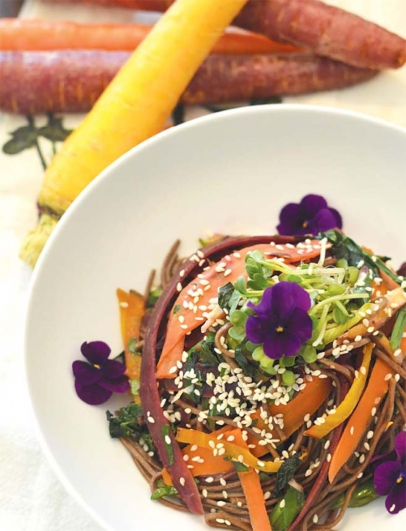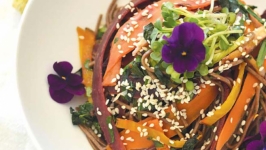It’s Tough Not to Like Carrots
Like Peter Rabbit and Bugs Bunny, I’ve never met a carrot I didn’t like.
Carrots are one of the first plantings in a spring garden. Seeds can be sown a few weeks before the last frost. Most varietals are ready for harvest between 60 and 70 days of planting, making them one of the first arrivals in your vegetable garden.
Known as a vegetable super food, carrots are highly nutritious. Rich in minerals and antioxidants, carrots are also a great source of fiber and vitamins, especially vitamin A. Remember your mom saying you should eat your carrots for better eyesight? Well, Mom had it half right. Although carrots won’t improve eyesight, it has been proven they aid in the prevention of vision loss. Deficiencies in vitamin A are one of the leading causes of blindness.
But don’t go carrot crazy. Eating too many can actually cause your skin to turn a light orange hue. Don’t fret too much about this carrot-eating side effect. You would need to eat at least 10 large carrots a day for two weeks to turn orange.
A TRUE ANCIENT ROOT
Like many vegetables and fruits now grown in the United States, carrots have their ancestral roots in another area of the world. The carrot was most likely first cultivated thousands of years ago in Asia around 300 BC. Those early carrots were small bitter roots that were purple, red, white and yellow. The one color not present in these ancient carrots? Orange. Thank the Dutch for the orange carrots that grace the majority of our country’s produce bins.
The Dutch orange carrot was developed during the 17th century through a process of selective cross breeding. The orange-colored carrot had increased sweetness and a minimal wooden core. Named Daucus carota, this new varietal quickly became popular throughout Europe. Carrots most likely found their way into American cuisine through earlier European settlers.
Today, the United States produces approximately 1.3 million tons of the nutrient-rich vegetable.
Braised, roasted, sautéed or raw, the sturdy carrot has proven an essential ingredient in today’s kitchen.
CRANK UP THE HEAT
A quick high-heat roast brings out the vegetable’s natural sugar, providing a nice caramelized effect while still leaving a bit of crispness. Crank up the heat to 450 degrees then toss those peeled carrots in olive oil along with a pinch of salt and a grind of black pepper. A 10- to 12-minute visit in that hot oven, and those carrots are set for their final garnish of chopped pistachios and crumbled feta cheese. And don’t throw out those carrot fronds. Keep a few to garnish your final presentation.
A 15-MINUTE FLATBREAD
Making interesting flatbread creations is a snap these days. Most grocery stores stock a variety of flatbread crusts including gluten-free versions. Think outside the flatbread topping box by incorporating thinly sliced multi-colored carrots into your creation. A handful of unassuming carrots can be transformed into an eye-popping flatbread when coupled with basil-infused ricotta cheese and a drizzle of extra-virgin olive oil.
Thinly slice the carrots (a mandoline slicer makes perfect slices) and give them a quick sauté in a skillet to soften. Spread a mixture of ricotta and fresh basil on top of a purchased flatbread crust. Top with the carrot mixture and bake in a 400-degree oven for 8 to 10 minutes to crisp. Finish the flatbread with a few drops of extra-virgin olive oil and a sprinkle of julienne basil.
OODLES OF NOODLES (AND CARROTS)
Begin the spring cooking season with a bowl full of noodles tossed with colorful vegetables including delicate ribbons of multi-colored carrots. Use soba noodles for a gluten-free option. Although these easy-to-cook noodles sound like they are made with wheat, buckwheat is technically derived from the seeds of a flowering plant. Double check the ingredient list when purchasing your soba noodles. Some brands sneak in a little wheat flour or may be packed in a facility that also processes wheat products.
Combine lightly sautéed carrot ribbons with roasted beets, kale and your favorite mushrooms. If you are a forager, this dish makes the perfect resting place for just-picked wild morels, though shiitake, crimini and oyster mushrooms also work well. A light sesame lime dressing finishes the noodle dish along with a healthy dose of chopped fresh cilantro.
If you are lucky enough to have some edible flowers blooming in your spring garden, pluck a few to crown your colorful carrot noodle bowl. And if you are not in the mood or don’t have the time to prepare one of these carrot-centric recipes, don’t fret. Just be like Bugs Bunny and Peter Rabbit. Pull out that fresh carrot, give it a good wash then bite right in for the perfect first taste of spring.








